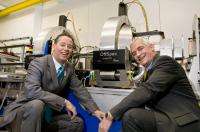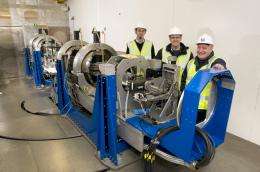Quantum leap for ISIS second target station

(PhysOrg.com) -- First published science results from new UK neutron source support Newton's ideas and quantum theory.
Scientists have used the UK's newest major science facility to finally make the connection between the reflection of particles and waves as required by quantum mechanics.
The phenomenon is a long established theory, but has not until now been seen. The result is the first to be published from the £200 million second target station recently opened at the ISIS Neutron Source in Oxfordshire and appears online today (January 8 2010) at Physical Review Letters. Whilst the discovery currently lies in the realm of pure physics, these results may initiate new developments in electronics, complementing the wave equivalent already used for photonics and metrology.
A team led by Rob Dalgliesh and Sean Langridge from the Science and Technology Facilities Council's ISIS facility and Victor de Haan from the Delft University of Technology (Netherlands) has proved experimentally for the first time that particles (in this case, neutrons) slide along a surface before they are reflected. This means that particles are reflected from a different point to the one where they arrived.
The spatial shift of a reflection was first suggested by Isaac Newton in the 17th century. Later in 1947 Goos and Hänchen used light to provide experimental evidence of Newton's suspicions and so was born the "Goos-Hänchen shift". The recent discovery from work at ISIS not only supports the ideas and work of Newton, Goos and Hänchen, but also proves that when particles are reflected they behave in exactly the same way as light, as predicted from quantum theory.
"Our results show that particles, in this case neutrons, behave in exactly the same way as light when they are reflected," says Professor Sean Langridge, an STFC research fellow at ISIS. "The capabilities of the new Offspec instrument that we have built at the ISIS second target station have allowed us to see this at the quantum level for the first time. The results provide us with further experimental evidence of the correctness and beauty of quantum mechanics and that ideas ranging from Newton to our present understanding of quantum phenomena are well founded," he said.
The experiment took place at the new second target station at the ISIS Neutron Source in Oxfordshire on the Offspec neutron instrument. The result was achieved by shining a beam of polarised neutrons onto a film of magnetic material and observing the minuscule change in polarisation after reflection. This incredible sensitivity was only possible through the development of the Offspec instrument and is collaboration between ISIS and the Delft University of Technology.
"This unique instrument as well as the first publication is the result of outstanding cooperation between the ISIS team and researchers from the Reactor Institute at Delft," said Professor Tim van de Hagen, Director of the Reactor Institute Delft.
ISIS is like a giant microscope that enables scientists to see things at scales 10,000 times thinner than a human hair. The capabilities of the instruments inside the second target station enabled the scientists to see in fine detail, and for the first time anywhere in the world, how such subtle effects seen in the reflection of light are reproduced by particles at the quantum level.
"It is extremely exciting to see the first results published from the science programme at the ISIS second target station," says Dr Andrew Taylor, Director of ISIS. "This is the first of many important results from the new instruments. And as well as pure science, they are also allowing us to contribute towards a wide range of contemporary global science challenges."

About Neutron Scattering
Neutron scattering is a vital research and analysis technique in exploring the structure and dynamics of materials and molecules. It provides unique and complementary information to that available from synchrotron light sources.
At ISIS, a synchrotron accelerator speeds a proton beam to 84 percent the speed of light before it is fired at a small tungsten target to make neutrons. The neutrons released from the target are then channeled along evacuated beam pipes into the material being examined.
Neutrons have no electric charge and penetrate deep inside materials. By looking at how neutrons scatter off the atoms inside materials, they reveal the atomic structure of the material under study. This enables researchers to correlate the structure of materials with their properties and understand how they behave in different circumstances.
Provided by ISIS
















